Themed collection Theranostic nanoplatforms for biomedicine

Introduction to theranostic nanoplatforms for biomedicine
Nguyen Thi Kim Thanh, Sylvie Begin, Sophie Laurent and Teresa Pellegrino introduce this Nanoscale and Nanoscale Advances themed issue on theranostic nanoplatforms for biomedicine.

Nanoscale, 2025,17, 19492-19495
https://doi.org/10.1039/D5NR90144H
Nanomaterial journey in the gut: from intestinal mucosal interaction to systemic transport
Nanomaterials interact with the gut microbiome, mucus layer, and epithelial cells, influencing immune responses and facilitating transport to distant organs via blood, lymphatic, and neural pathways, impacting intestinal and systemic health.

Nanoscale, 2024,16, 19207-19220
https://doi.org/10.1039/D4NR02480J
Advances in biomimetic AIE nanoparticles for diagnosis and phototherapy
An overview of the development of biomimetic AIE nanoparticles and their biomedical applications.

Nanoscale, 2024,16, 14707-14715
https://doi.org/10.1039/D4NR01417K
Nanomedicines for targeted pulmonary delivery: receptor-mediated strategy and alternatives
In this review, we provide a comprehensive overview and analysis of the current advancements in nanomedicines for targeted pulmonary delivery.

Nanoscale, 2024,16, 2820-2833
https://doi.org/10.1039/D3NR05487J
Understanding the interplay between pH and charges for theranostic nanomaterials
Nanotechnology enables targeted theranostics by enhancing imaging and therapy. This review explores advances in pH-induced charge-switchable nanomaterials, their role in drug delivery and imaging contrast, and future directions in the field.

Nanoscale, 2025,17, 6960-6980
https://doi.org/10.1039/D4NR03706E
Progress in nanoparticle-based electrochemical biosensors for hormone detection
A critical comparison between different types of nanoparticle-based electrochemical biosensors for the detection of various hormones.

Nanoscale, 2024,16, 18134-18164
https://doi.org/10.1039/D4NR02075H
Magnetic iron oxide nanogels for combined hyperthermia and drug delivery for cancer treatment
Simultaneous hyperthermia and drug delivery with magnetic iron oxide nanogels.

Nanoscale, 2024,16, 15446-15464
https://doi.org/10.1039/D4NR02058H
The recent advancements in protein nanoparticles for immunotherapy
An overview of the advancements in protein nanoparticles for immunotherapy across diseases include cancer and other diseases like influenza, pneumonia, and hepatitis.

Nanoscale, 2024,16, 11825-11848
https://doi.org/10.1039/D4NR00537F
Advanced micro/nano-electroporation for gene therapy: recent advances and future outlook
Advanced micro/nano fabrication techniques have revolutionized electroporation technology. Electroporation devices with micro/nanostructures mediating safe, precise and controllable electrotransfection continue to adapt to the field of gene therapy.

Nanoscale, 2024,16, 10500-10521
https://doi.org/10.1039/D4NR01408A
Cell membrane coated nanoparticles as a biomimetic drug delivery platform for enhancing cancer immunotherapy
Graphical abstract of CMNPs delivering different therapeutic agents for enhancing cancer immunotherapy.
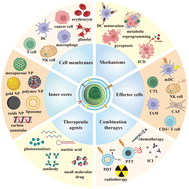
Nanoscale, 2024,16, 8708-8738
https://doi.org/10.1039/D4NR00284A
Nanomedicine as a multimodal therapeutic paradigm against cancer: on the way forward in advancing precision therapy
Graphical representation of recent advancements in combinatorial anticancer treatment modalities.
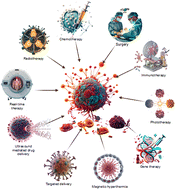
Nanoscale, 2024,16, 6330-6364
https://doi.org/10.1039/D3NR06131K
Spherical nucleic acids: emerging amplifiers for therapeutic nanoplatforms
This review summarizes the amplification effect of SNAs in various combined therapy treatment strategies and highlights the recent advances of SNAs in clinical translation.
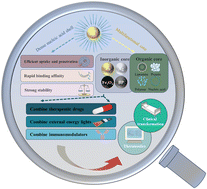
Nanoscale, 2024,16, 4392-4406
https://doi.org/10.1039/D3NR05971E
In situ peptide assemblies for bacterial infection imaging and treatment
In situ peptide assemblies have attracted considerable attention as promising alternatives in bacterial infection imaging and treatment.
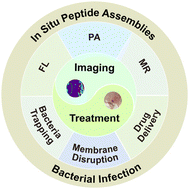
Nanoscale, 2024,16, 3211-3225
https://doi.org/10.1039/D3NR05557D
Recent advances in biomaterial designs for assisting CAR-T cell therapy towards potential solid tumor treatment
Advances in functional biomaterial designs for assisting CAR-T therapy against solid tumors.
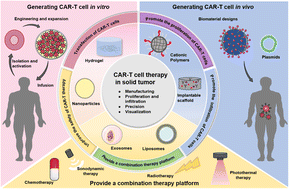
Nanoscale, 2024,16, 3226-3242
https://doi.org/10.1039/D3NR05768B
Composition, preparation methods, and applications of nanoniosomes as codelivery systems: a review of emerging therapies with emphasis on cancer
Nanoniosome-based drug codelivery systems have become popular therapeutic instruments, demonstrating tremendous promise in cancer therapy, infection treatment, and other therapeutic domains.

Nanoscale, 2024,16, 2713-2746
https://doi.org/10.1039/D3NR03495J
A comprehensive exploration of the latest innovations for advancements in enhancing selectivity of nanozymes for theranostic nanoplatforms
This work explores cutting-edge strategies to enhance nanozyme selectivity, vital for improving diagnostics and treatments, unlocking their full theranostic potential.

Nanoscale, 2023,15, 15885-15905
https://doi.org/10.1039/D3NR03327A
Multifunctional GQDs for receptor targeting, drug delivery, and bioimaging in pancreatic cancer
Pancreatic cancer is a devastating disease with a low survival rate and limited treatment options and in this context, multifunctional graphene quantum dot-based receptor targeting, drug delivery, and bioimaging possess immense potential to cure pancreatic cancer.
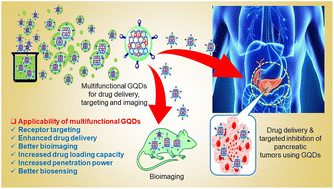
Nanoscale, 2023,15, 14698-14716
https://doi.org/10.1039/D3NR03161F
A natural food-grade supramolecular self-assembly system for creation of hierarchically structured hydrogels
We develop a hierarchically structured hydrogel by supramolecular self-assembly of all-natural building blocks, glycyrrhizic acid and carrageenan, which can serve as responsive active cargo delivery platforms for food and biomedical applications.

Nanoscale, 2024,16, 14261-14268
https://doi.org/10.1039/D4NR01410C
Bayesian optimization of glycopolymer structures for the interaction with cholera toxin B subunit
The optimal structure of synthetic glycopolymers for GM1 mimetics was determined through Bayesian optimization.

Nanoscale, 2024,16, 12406-12410
https://doi.org/10.1039/D4NR00915K
In vivo biodistribution and tumor uptake of [64Cu]-FAU nanozeolite via positron emission tomography Imaging
Nanoparticles have emerged as promising theranostic tools for biomedical applications, notably in the treatment of cancers.
![Graphical abstract: In vivo biodistribution and tumor uptake of [64Cu]-FAU nanozeolite via positron emission tomography Imaging](/en/Image/Get?imageInfo.ImageType=GA&imageInfo.ImageIdentifier.ManuscriptID=D3NR05947B&imageInfo.ImageIdentifier.Year=2024)
Nanoscale, 2024,16, 11959-11968
https://doi.org/10.1039/D3NR05947B
Near-infrared AIEgens for sulfatase imaging in breast cancer in vivo
A near-infrared aggregation induced-emission luminogen QMT-SFA was designed for sensitive and real-time imaging of sulfatase activity in breast tumor cells and in vivo.

Nanoscale, 2024,16, 11538-11541
https://doi.org/10.1039/D4NR01314J
Microfluidic-assisted formulation of cell membrane-camouflaged anisotropic nanostructures
This work reports the development of a high-throughput microfluidic-based platform for the formulation of cell membrane-camouflaged anisotropic gold nanostructures with minimized phagocytic uptake and enhanced cancer cell targeting.

Nanoscale, 2024,16, 7874-7883
https://doi.org/10.1039/D4NR00415A
Spacer engineering in nanoparticle–peptide conjugates boosts targeting specificity for tumor-associated antigens
Orientation and steric hindrance decrease the efficiency for an antibody to attach to its specific receptor. Giving flexibility to a dendronized peptide through a small PEG fragment increases the peptides affinity to cellular receptors.

Nanoscale, 2025,17, 5021-5032
https://doi.org/10.1039/D4NR02931C
Fabrication of nanoparticles with precisely controllable plasmonic properties as tools for biomedical applications
Highly homogenous nanoparticles fabricated via nanoimprint lithography with minimal batch-to-batch size variation and tailor-made plasmonic properties. Polymer surface modification ensures functionality, good biocompatibility and minor cytotoxicity.

Nanoscale, 2025,17, 4423-4438
https://doi.org/10.1039/D4NR02677B
MPI performance of magnetic nanoparticles depends on matrix composition and temperature: implications for in vivo MPI signal amplitude, spatial resolution, and tracer quantification
The compressibility, viscosity, and temperature of hydrogel tissue phantoms affect the MPI signal of MNP tracers, which may impact accurate in vivo tracer quantification.

Nanoscale Adv., 2025,7, 1018-1029
https://doi.org/10.1039/D4NA00518J
Portfolio of colloidally stable gold–gold sulfide nanoparticles and their use in broad-band photoacoustic imaging
Growing interest in non-invasive photoacoustic imaging is driving the demand for non-toxic, stable, optical absorbers, particularly those operating in the visible and near-infrared regions to enable deep tissue penetration

Nanoscale, 2025,17, 1371-1380
https://doi.org/10.1039/D4NR03509G
Key factors influencing magnetic nanoparticle-based photothermal therapy: physicochemical properties, irradiation power, and particle concentration in vitro
The photothermal properties of a collection of magnetic nanoparticles were analyzed. One of these sets of particles was further tested in vitro triggering cell death after 10 minutes of laser exposure.

Nanoscale Adv., 2025,7, 336-345
https://doi.org/10.1039/D4NA00384E
Encapsulated mitochondria to reprogram the metabolism of M2-type macrophages for anti-tumor therapy
In this study, our innovative Mito@ZiF-8 system enhances the functionality of isolated mitochondria and reprograms M2 macrophage metabolism upon delivery, ultimately, reducing the tumorigenic potential of breast cancer cells.

Nanoscale, 2024,16, 20925-20939
https://doi.org/10.1039/D4NR02471K
Defects or no defects? Or how to design 20–25 nm spherical iron oxide nanoparticles to harness both magnetic hyperthermia and photothermia
Tuning the synthesis of iron oxide nanoparticles (IONPs) to modulate structural and vacancy defects has shown that IONPs with fewer defects are more suitable for combining MH and PTT with high efficiency.

Nanoscale, 2024,16, 20542-20555
https://doi.org/10.1039/D4NR01397B
Improved tumour delivery of iron oxide nanoparticles for magnetic hyperthermia therapy of melanoma via ultrasound guidance and 111In SPECT quantification
We increased the accuracy of tumour nanoparticle delivery using real-time ultrasound imaging and slow syringe-pump controlled infusion. This minimises off-target side effects for better and safer melanoma treatment using magnetic hyperthermia.

Nanoscale, 2024,16, 19715-19729
https://doi.org/10.1039/D4NR00240G
Enhanced antibacterial efficacy: rapid analysis of silver-decorated azithromycin-infused Soluplus® nanoparticles against E. coli and S. epidermidis biofilms
The threat of antibiotic-resistent biofilms demands solutions. Silver-coated azithromycin-Soluplus nanoparticles release silver ions for 6+ hours, disrupt biofilms, and enable rapid, sensitive bacterial detection with laser-induced graphene sensors.

Nanoscale, 2024,16, 17877-17885
https://doi.org/10.1039/D4NR02583K
Near infra-red luminescent osmium labelled gold nanoparticles for cellular imaging and singlet oxygen generation
Dual modality nanoprobes with enhanced theranostic properties are designed by decoration of gold nanoparticles with osmium complexes for imaging in the near-infrared and singlet oxygen production, leading to new localised therapy approaches.

Nanoscale, 2024,16, 16500-16509
https://doi.org/10.1039/D4NR01901F
Facile roll-to-roll production of nanoporous fiber coatings for advanced wound care sutures
A novel electrospinning technique for fast and cost-effective roll-to-roll production of nanofiber-coated sutures with smart drug-releasing capability is introduced, enabling advanced wound care.

Nanoscale, 2024,16, 15615-15628
https://doi.org/10.1039/D4NR01432D
Tailoring the pore structure of iron oxide core@stellate mesoporous silica shell nanocomposites: effects on MRI and magnetic hyperthermia properties and applicability to anti-cancer therapies
The controlled growth of stellate silica shells around iron oxide nanoparticles allows the design of novel efficient theranostics for MRI, magnetic hyperthermia and photothermia.

Nanoscale, 2024,16, 15585-15614
https://doi.org/10.1039/D4NR01388C
Semisynthetic ferritin-based nanoparticles with high magnetic anisotropy for spatial magnetic manipulation and inductive heating
The core of the semi-synthetic magnetic nanoparticle magnetoferritin was doped with cobalt or zinc in order to evaluate its applicability as a nanoagent for intracellular target redistribution or localised heat dissipation via magnetic hyperthermia.

Nanoscale, 2024,16, 15113-15127
https://doi.org/10.1039/D4NR01652A
High-load nanoparticles with a chemotherapeutic SN-38/FdUMP drug cocktail
A cocktail of chemotherapeutic SN-38 and 5-FU/FdUMP in [Gd(OH)]2+[(SN-38)0.5(FdUMP)0.5]2− inorganic-organic hybrid nanoparticles shows promising efficacy on mouse pancreatic cancer cell lines.

Nanoscale, 2024,16, 14853-14860
https://doi.org/10.1039/D4NR01403K
Understanding magnetic hyperthermia performance within the “Brezovich criterion”: beyond the uniaxial anisotropy description
Our study shows that intrinsic magnetocrystalline anisotropy plays a critical role in magnetic hyperthermia. Results indicate that even small deviations from spherical shape have an important impact on optimizing SLP.

Nanoscale, 2024,16, 14319-14329
https://doi.org/10.1039/D4NR02045F
Modulating efficacy and cytotoxicity of lipoamino fatty acid nucleic acid carriers using disulfide or hydrophobic spacers
Double pH-responsive xenopeptides comprising polar ionizable succinoyl tetraethylene pentamine (Stp) motifs and lipophilic ionizable lipoamino fatty acids (LAFs) were recently found to efficiently transfect mRNA and pDNA at low doses.

Nanoscale, 2024,16, 13988-14005
https://doi.org/10.1039/D4NR01357C
A novel nanocomposite drug delivery system for SARS-CoV-2 infections
To develop an inhalable drug delivery system, we synthesized Remdesivir-loaded nanocomposites (RDV NCs) by coating drug-loaded nanoparticles with supramolecular cell-penetrating peptide nanofibers, enhancing uptake and intracellular drug delivery.

Nanoscale Adv., 2024,6, 3747-3758
https://doi.org/10.1039/D4NA00361F
Quantum dots as a fluorescent labeling tool for live-cell imaging of Leptospira
ConA-coated QDs allow live-cell labeling of Leptospira, which is a class of pathogenic bacteria causing Leptospirosis.

Nanoscale, 2024,16, 13677-13686
https://doi.org/10.1039/D4NR00543K
Copper nitroprusside analogue nanoparticles against melanoma: detailed in vitro and in vivo investigation
Overall schematic presentation depicting the anti cancer property of CuNPANP towards melanoma through in vitro and in vivo studies.

Nanoscale, 2024,16, 13580-13596
https://doi.org/10.1039/D4NR01857E
A gold nanocluster/MIL-100(Fe) bimodal nanovector for the therapy of inflammatory disease through attenuation of Toll-like receptor signaling
We designed a novel class of anti-inflammatory nanomedicines. It exhibited high cytotoxicity to activated macrophages was able to reduce the secretion of pro-inflammatory cytokines and inhibit the Toll-like receptor signaling cascade.

Nanoscale, 2024,16, 12037-12049
https://doi.org/10.1039/D3NR06685A
Enhancing MRI through high loading of superparamagnetic nanogels with high sensitivity to the tumor environment
A novel γ-Fe2O3@PNIPAm/PAm/CTS hybrid nanogel using a surfactant-free emulsion copolymerization process exhibited temperature- and pH-sensitivity, enabling magnetic targeting and enhancing diagnosis through MRI.

Nanoscale Adv., 2024,6, 3367-3376
https://doi.org/10.1039/D4NA00014E
Designing functionalized nanodiamonds with hyaluronic acid–phospholipid conjugates for enhanced cancer cell targeting and fluorescence imaging capabilities
Novel approach for the functionalization of nanodiamonds with Hyaluronic Acid is proposed, utilizing non-covalent anchoring. NDs exhibit improved properties including increased internalization in human adenocarcinoma cells overexpressing CD44 receptor.

Nanoscale, 2024,16, 11610-11622
https://doi.org/10.1039/D4NR00932K
A natural killer T cell nanoagonist-initiated immune cascade for hepatocellular carcinoma synergistic immunotherapy
The hyaluronic acid modified zeolitic imidazolate framework-8 encapsulating α-galactosylceramide and doxorubicin, can effectively trigger NKT cell-mediated immune responses along with antitumor chemotoxicity.

Nanoscale, 2024,16, 11126-11137
https://doi.org/10.1039/D4NR00847B
A chitosan-coated PCL/nano-hydroxyapatite aerogel integrated with a nanofiber membrane for providing antibacterial activity and guiding bone regeneration
A chitosan-coated PCL/nano-hydroxyapatite aerogel was integrated with a nanofiber membrane for constructing a GBR material. Such a material can serve as a barrier and exhibit promising potential in terms of antibacterial properties and guidance of bone regeneration.

Nanoscale, 2024,16, 9861-9874
https://doi.org/10.1039/D4NR00563E
Novel PLGA-based nanoformulation decreases doxorubicin-induced cardiotoxicity
Nanoformulations decrease systemic toxicity effects of antitumor agents.

Nanoscale, 2024,16, 9412-9425
https://doi.org/10.1039/D3NR06269D
A metal–organic cage-derived cascade antioxidant nanozyme to mitigate renal ischemia-reperfusion injury
An MOC-based cascade nanozyme with relatively definite structures was developed and it scavenged ROS to alleviate renal I/R injury.

Nanoscale, 2024,16, 9406-9411
https://doi.org/10.1039/D4NR00742E
Coaxial dual-path electrochemical biosensing and logic strategy-based detection of lung cancer-derived exosomal PD-L1
Schematic illustration of the construction of coaxial dual-path electrochemical biosensor for highly accurate recognition and detection of lung cancer-derived exosomal PD-L1.
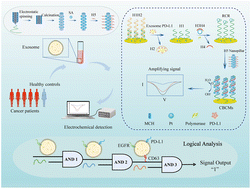
Nanoscale, 2024,16, 8950-8959
https://doi.org/10.1039/D4NR00412D
A photo-responsive self-healing hydrogel loaded with immunoadjuvants and MoS2 nanosheets for combating post-resection breast cancer recurrence
A photo-responsive self-healing hydrogel-mediated photothermal therapy combined with immune checkpoint blockade effectively inhibited the recurrence of resected tumors, offering insights against post-resection breast cancer recurrence.
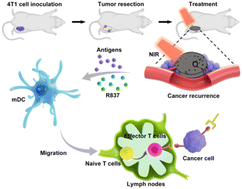
Nanoscale, 2024,16, 8417-8426
https://doi.org/10.1039/D4NR00372A
Sphingomyelinase-responsive nanomicelles for targeting atherosclerosis
Sphingomyelinase enzymatic activity destabilises iron oxide nanomicelles and promotes its accumulation in atherosclerosis in vivo.
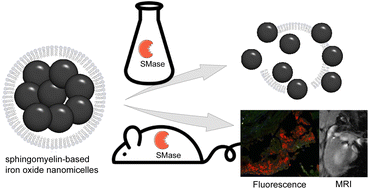
Nanoscale, 2024,16, 6477-6487
https://doi.org/10.1039/D3NR06507C
Enhanced theranostic efficacy of epirubicin-loaded SPION@MSN through co-delivery of an anti-miR-21-expressing plasmid and ZIF-8 hybridization to target colon adenocarcinoma
The SPION@MSN-EPI/pDNA-ZIF-8-PEG-Apt nanocarrier showcases exceptional plasmid stability, drug loading, and controlled release. Its outstanding anti-tumor efficacy through targeted chemo–gene therapy is supported by its imaging traceability.
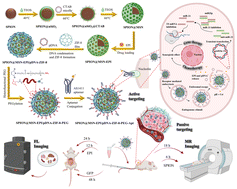
Nanoscale, 2024,16, 6215-6240
https://doi.org/10.1039/D3NR06642H
SERS nanostructures with engineered active peptides against an immune checkpoint protein
Engineered peptides on plasmonic nanostructures show a good targeting activity against the immune checkpoint programmed death ligand 1 protein (PD-L1) expressed by tumor cells. SERS signals allow quantitative evaluation of the targeting activity.

Nanoscale, 2024,16, 5206-5214
https://doi.org/10.1039/D4NR00172A
Mechanism of RGD-conjugated nanodevice binding to its target protein integrin αVβ3 by atomistic molecular dynamics and machine learning
Based on atomistic molecular dynamics simulations and machine learning approaches we unveil the binding mechanism of a cyclic-RGD-ligand activated NP (PEGylated-TiO2) to its receptor protein (integrin-αVβ3) overexpressed in many tumor cells.

Nanoscale, 2024,16, 4063-4081
https://doi.org/10.1039/D3NR05123D
Multiparametric modulation of magnetic transduction for biomolecular sensing in liquids
The transducing capacity of magnetic nanoparticles for biomarker detection in AC magnetometry lies in a number of modulating parameters. This is assessed through the variations of AC magnetic hysteresis area in absence (black colour, A0) and presence (violet colour, A) of analytes.
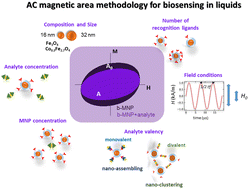
Nanoscale, 2024,16, 4082-4094
https://doi.org/10.1039/D3NR06489A
Oxygen self-supplying small size magnetic nanoenzymes for synergistic photodynamic and catalytic therapy of breast cancer
In this study, we developed oxygen-supplying magnetic bead nanozymes that integrate hemoglobin and encapsulate the photosensitizer curcumin, demonstrating reactive oxygen species (ROS)-induced synergistic breast cancer therapy.

Nanoscale, 2024,16, 4095-4104
https://doi.org/10.1039/D3NR05289C
A study of complexation and biological fate of polyethyleneimine-siRNA polyplexes in vitro and in vivo by fluorescence correlation spectroscopy and positron emission tomography imaging
Fluorescence correlation spectroscopy and positron emission tomography are used to study the formation of PEI siRNA polyplex nanoparticles and to trace their biological fate at cell level and in vivo.

Nanoscale, 2024,16, 3525-3533
https://doi.org/10.1039/D3NR04026G
Magnetic coagulometry: towards a new nanotechnological tool for ex vivo monitoring coagulation in human whole blood
Blood clotting disorders are among the main causes of death worldwide. Magnetic coagulometry provides a new method to test coagulation in human whole blood ex vivo, offering grounds for the improvement of current methods in research and clinic.

Nanoscale, 2024,16, 3534-3548
https://doi.org/10.1039/D3NR02593D
Functional magnetic nanoparticles for protein delivery applications: understanding protein–nanoparticle interactions
Magnetic iron oxide nanoparticles coated with PNIPMAM polymer can encapsulate protein guests and release them upon (magnetic) heating above 45 °C in the presence of competitor proteins.
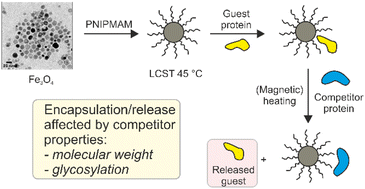
Nanoscale, 2024,16, 2466-2477
https://doi.org/10.1039/D3NR04544G
Nitric oxide releasing novel amino acid-derived polymeric nanotherapeutic with anti-inflammatory properties for rapid wound tissue regeneration
The prepared PNAG NPs loaded with SNPs induce cell migration, proliferation, and angiogenesis, thus reducing inflammation and accelerating in vivo wound healing.
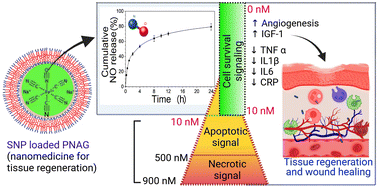
Nanoscale, 2024,16, 1770-1791
https://doi.org/10.1039/D3NR03923D
Poly(glycerol monomethacrylate)-encapsulated upconverting nanoparticles prepared by miniemulsion polymerization: morphology, chemical stability, antifouling properties and toxicity evaluation
Highly colloidally stable upconverting nanoparticles encapsulated in poly(glycerol monomethacrylate) by RAFT miniemulsion polymerization were non-toxic and exhibited antifouling properties.

Nanoscale Adv., 2023,5, 6979-6989
https://doi.org/10.1039/D3NA00793F
Nanobubble-mediated cancer cell sonoporation using low-frequency ultrasound
We developed an improved sonoporation method using nanobubbles, offering potential for noninvasive uses. Our results confirmed that low frequency insonation yields sonoporation outcomes comparable to those achieved with targeted microbubbles.

Nanoscale, 2023,15, 17899-17909
https://doi.org/10.1039/D3NR03226D
Carbonized polymer dots derived from metformin and L-arginine for tumor cell membrane- and mitochondria-dual targeting therapy
We first prepared carbonized polymer dots (MA-dots) from metformin and L-arginine to target the tumor cell membrane and mitochondria for antitumor therapy.

Nanoscale, 2023,15, 17922-17935
https://doi.org/10.1039/D3NR04145J
A cascade nanoplatform for the regulation of the tumor microenvironment and combined cancer therapy
MCDGF can regulate the tumor immune microenvironment and suppress tumor growth by combined therapy, promoting the clinical application of disulfiram.

Nanoscale, 2023,15, 16314-16322
https://doi.org/10.1039/D3NR03199C
Functionalized manganese iron oxide nanoparticles: a dual potential magneto-chemotherapeutic cargo in a 3D breast cancer model
Dual magneto-chemotherapeutic effects on a 3D breast cancer model after 10, 20 and 30 min of treatment.

Nanoscale, 2023,15, 15686-15699
https://doi.org/10.1039/D3NR02816J
Anatase TiO2−x and zwitterionic porphyrin polymer-based nanocomposite for enhanced cancer photodynamic therapy
To improve the photodynamic therapy (PDT) outcomes and the ability to specifically target cancer cells of TiO2, anatase TiO2-x and zwitterionic porphyrin polymer-based nanocomposite TiO2-x@TFPC is used as the enhanced PDT agent for treating cancer.

Nanoscale, 2023,15, 14790-14799
https://doi.org/10.1039/D3NR03012A
About this collection
Guest Edited by Professor Nguyen T. K. Thanh (University College London, UK), Professor Sophie Laurent (University of Mons, Belgium), Professor Sylvie Begin-Colin (University of Strasbourg, France) and Professor Teresa Pellegrino (Italian Institute of Technology, Italy).
For nanomedicine to fill its promise, either direct intratumoral injection or active targeting with affinity ligands to achieve favourable specificity and biodistribution profiles is critical for accurate detection, monitoring and therapeutic efficacy. Such smart approaches, when translated to clinical uses, will have a great impact on the management of cancer and other diseases to improve patient survival and quality of life. However, for further clinical translation of nanoplatforms, a key step is their scale-up.
The collection focuses on the design of multifunctional hybrid nanomaterials for theranostics in biomedicine, with a focus on the scaling-up of these nanomaterials for translational studies. The scope of this collection loosely aligns with Symposium J – Design and scaling up of theranostic nanoplatforms for health: towards translational studies held in early 2023 at the Spring E-MRS meeting, and focuses on the design, synthesis and characterization of nanoparticles (including inorganic, polymers, liposomes, and dendrimers), targeting strategies, multimodal Imaging (e.g., MRI, MPI, SPECT, PET), multimodal therapy (e.g., hyperthermia, curie therapy), drug delivery, nanotoxicology, in vitro and in vivo validation of nanoplatforms combining multimodal imaging and therapies, scaling-up strategies of nanoplatform synthesis, and new synthesis processes taking into account good manufacturing practice (GMP) and environmental considerations.